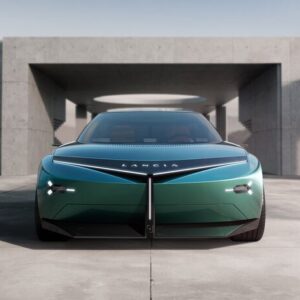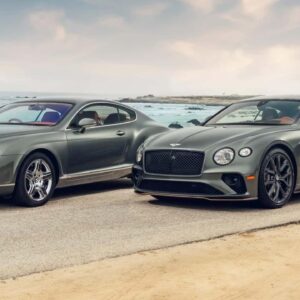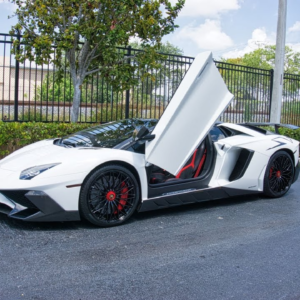Overview
While rival muscle cars have pivoted recently toward sharp handling, the 2023 Dodge Challenger keeps things retro with a package that’s designed more for old-school pony-car jollies and straight-line speed. A V-6 engine is standard in these non-SRT Challengers but the real fun comes with the optional naturally aspirated Hemi V-8 engines, which are offered in a variety of displacements and outputs spanning a 375-hp, 5.7-liter to a 485-hp, 6.4-liter. If you want even more power, Dodge will be happy to oblige with the big-stomper Challenger SRT Hellcat, which we review separately. The regular Challenger isn’t as intense as the outrageous Hellcat, but for some its V-8 burble and relatively comfortable ride will be enough to trigger nostalgic feelings for the vintage Dodge pony cars with which it shares a name. Enthusiast drivers will find modern versions of the Chevrolet Camaro and the Ford Mustang more capable on twisty roads and racetracks, but the Challenger’s old-school charm is undeniable.
What’s New for 2023?
This year marks the end of an era for the Challenger coupe as Dodge prepares a next-generation model, likely with an electric powertrain. The 2023 Challenger wears special commemorative plaques under the hood to indicate the final model year of the current generation, and Dodge will offer popular colors from the car’s past, including Plum Crazy, B5 Blue, and Sublime Green. All R/T models gain a new “345” badge on the front fender to pay tribute to the Hemi V-8 engine that resides under the car’s long, vented hood. The first of these seven special editions Dodge is calling the Shakedown. Only 1000 will be built. The Shakedown edition will be split between the 485-hp R/T Scat Pack and its Widebody twin and likely cost between $55k–$65k.
Pricing and Which One to Buy
We’d select the R/T Scat Pack model for its 485-hp 6.4-liter V-8. Believe it or not, we’d opt for the eight-speed automatic over the standard manual transmission because it’s much more responsive than the slushy-feeling stick shift. We’d also add the adaptive dampers for adjustable ride quality, and the Dynamics package for its wide 20-inch wheels, six-piston Brembo front brakes, and leather-wrapped steering wheel. The Plus package improves the interior with ambient lighting, faux-suede seat inserts, and much nicer materials on the dashboard and doors. It requires the Driver Convenience Group, too, which brings blind-spot monitoring, rear-cross-traffic alert, power mirrors, and high-intensity-discharge headlights.
Engine, Transmission, and Performance
The Challenger’s base 305-hp V-6 won’t satisfy thrill seekers. The modest engine mates exclusively to the eight-speed automatic, but in the heavy Challenger, it lacks the acceleration and excitement of rivals. The Dodge’s Hemi V-8 engines are another story. The 375-hp 5.7-liter we tested had plenty of juice to powerslide on demand, and its guttural growl was gratifying. Those looking to maximize the Challenger’s potential will want the 6.4-liter V-8, which produces 485 horsepower and 475 pound-feet of torque. We also drove the T/A 392 with the automatic and admired the exhaust’s cannon-blast startup sound and baritone roar when prodded. While we’re suckers for a manual transmission, the automatic is incredibly responsive to throttle inputs, with quick power-on downshifts. The Challenger hustles through corners like a raging bull seeing red, snorting aggressively and swaying threateningly. The burly Dodge is a muscle car in the truest sense: It’s better on the street and the drag strip than on two-lanes and road courses. Since the lineup’s redesign in 2015, the models we’ve driven have offered a compliant ride that’s comfortable but a bit unrefined. Compared with the sharper and stickier handling of the Camaro and Mustang, however, the Challenger is too soft in tight turns and its steering is too numb. The slow-to-react helm is well suited to leisurely drives and easily controlled power-induced tail slides.

Fuel Economy and Real-World MPG
The rear-drive, V-6-powered Challenger is estimated to earn 19 mpg city and 30 highway. Adding all-wheel drive into the mix lowers those ratings by 1 and 3 mpg, respectively. Challengers with the 5.7-liter V-8 are expected to earn up to 16 mpg city and 25 highway. Versions with the 6.4-liter V-8 are rated up to 15 mpg city and 24 highway. We’ve tested the all-wheel-drive V-6 Challenger and one with the 485-hp V-8 and automatic transmission on our 75-mph real-world route, which is part of our extensive testing regimen. Surprisingly, they both earned 26 mpg on the highway. For more information about the Challenger’s fuel economy, visit the EPA’s website.
Interior, Comfort, and Cargo
The Challenger has a classic muscle-car interior, with a simple design inspired by its 1970s-era predecessors and comfortable accommodations. Compared with its pony-car rivals, the Dodge is far roomier inside, and adults can actually use the back seat. Unfortunately, its rubberized materials resemble old vinyl rather than premium plastic, and rear visibility is lousy. The Challenger’s broad front seats are comfortable for cruising, but even the optional seats, which have added bolstering, don’t hug their occupants the way those in the Camaro or Mustang do. Dodge’s pony car has an extra seven cubic feet of cargo space in its trunk versus the Camaro. This allows the Challenger to swallow two more bags of luggage than the Camaro. Fold the back seats down and that advantage grows to six. The Challenger has a big center-console bin and a useful spot for a smartphone. Still, none of the cars we tested in this class was particularly adept at storing small items.

Infotainment and Connectivity
Every Challenger has a version of Dodge’s easy-to-use Uconnect infotainment system. The feature-filled unit includes Apple CarPlay and Android Auto integration as standard equipment. Looking to get the Led out? Listen to Jimmy Page’s spine-tingling guitar riffs with one of two optional Alpine audio systems or the crème-de-la-crème 900-watt, 18-speaker Harman/Kardon setup.
































